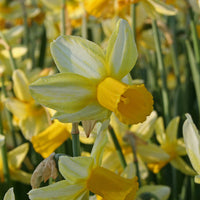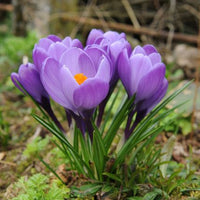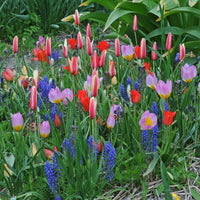Red doesn't run
'No, red is not going well, they want pink now'. The words of friend Fred who runs a tulip nursery in Hensbroek in West Friesland. Tulips in the greenhouse at Borst Flower Bulbs in Obdam
I had promised Vlad and Pauliina that I would take them to a tulip nursery around Valentine’s Day or International Women’s Day to show them what happens to most tulips. Vlad is originally from Moldova; Pauliina is from Helsinki (hence the second i in her name—and in case you didn’t know—it’s Finnish for Paulien). After working with us for a while, I can imagine that they think that tulips are mostly used in gardens and in pots for patios. That’s not entirely true, because the vast majority of tulips are used to produce a bunch of flowers in the winter months. What do Pauliina and Vlad do with us? Well, we don't really know either. They are in the office and they are sociable. No, that's just kidding of course, they are both IT people, and when you hear that, most of you will know that it is also somewhat true when we say that we have no idea what they are doing. They are actually a bit like the surgeons of the Fluwel webshop. Where it goes beyond us, people with calluses on our fingers and gunk under our nails, they calmly sit behind the screen with a cup of tea and solve all problems.
But we were talking about the Broeierij van Tulpen, I know more about that. Something I also know a bit about is photography. One of the assignments during a photography course I once followed was: 'Tell a story in seven photos.' I was allowed to use text, but only one-liners (not really easy for me). I'm going to try that now, because I promised you last week that I would also talk about the beautiful Dahlia assortment: after all, it is now available in the Fluwel webshop. So. The Broeierij van Tulpen in seven photos. (We don't count the first one you've already seen, those are tulips in the greenhouse.)
Tulips are planted in trays and put in the cold store for three to four months for a cold treatment. This cold period is necessary to give the Tulip bulb the idea that winter is over and that it is time to start growing and flowering.
When the tulips are ripe enough to harvest, they are automatically rolled forward and the flowers can be harvested.
The pickers place the harvested tulips on a conveyor belt, which takes them to the bunching machine.
Before the tulips enter the bunching machine, they are grabbed by two rubber bands and hang upside down.
Another machine—which wishes to remain anonymous and prefers not to be seen—cuts off the bulbs.
The tulips are then grabbed at the end of their stem by a clamp from the bunching machine.
The bunching machine counts bunches of 10 tulips, turns them over a bit and places them neatly on a conveyor belt.
The bunches are rolled up in paper in bundles of 5—so 50 tulips per bundle—and placed in flower pots.
The flower tubs with tulips are put on an auction cart and driven into the cold store. They are picked up during the night to be sold the next morning at six o'clock at the flower auction in Aalsmeer.
You understand, Vlad and Pauliina were amazed. Especially at Borst Bloembollen in Obdam they went from one surprise to the next and felt like Sjaakie in a Chocolate Factory. Dahlia Bumble Rumble
But I promised you last week to tell you about Dahlias in this newsletter. The first ones will be shipped in the coming days, and if you ordered early you can expect yours soon. Unfortunately, I sometimes hear from customers who email about a disappointing result that the Dahlias are not always stored properly. When we try to find out what happened, it turns out that the tubers are unpacked upon receipt and stored dry until the end of April, without packaging. This is wrong, because the Dahlias dry out enormously and that is very detrimental to the quality. A dried out Dahlia tuber takes much longer to get going or sometimes even gives up the ghost completely. Of course we will help you if this happens to you and you can try again with new Dahlias. Here is what you should do: Dahlia Caitlin's Joy
The Dahlias you receive are in a porous plastic bag, which allows oxygen to enter but does not allow moisture to escape. If you leave the tubers in this bag until planting around the end of April, beginning of May, they will remain in good condition. If you do unpack them, store them wrapped in newspapers or cloths, but do not leave them naked in the shed. Make sure they are in a cool place where frost cannot reach: freezing is fatal for the Dahlia tuber. Why do you send the Dahlias so early, you may wonder. We do this because there are also many people who want to force the Dahlia. Forcing a Dahlia is actually starting the Dahlia faster, so that they come into bloom earlier in your garden. It is very simple: you plant the Dahlia in a pot with potting soil and store it in the shed or another frost-free place in or around the house.
If you do this in March, you will see that they will already be growing nicely by the time you put them in the garden at the end of April. Of course, you must keep the potting soil moist. This way, the Dahlia tubers can already develop a good root system before they go into the garden. When the danger of night frost has passed, you can carefully remove them from the pot and plant them in the garden. By doing this, you have two advantages: firstly, they will really come into flower three or four weeks earlier and, secondly and perhaps even more importantly: the snail has less of a hold on them. Of course, that slimy girl will nibble on your Dahlia if it has the chance, but it will not gobble up the whole plant so quickly. With a small germinating plant, that is of course a piece of cake for the snail, and by forcing it forward, it becomes more difficult.
Feel free to take a look in our Dahlia shop, the choice is huge. I'm going back to my Daffodils in the greenhouse, I'll be back next week.
Kind regards,
Carlos van der Veek
Oh yes, the title Red is not running. That's what Fred said. Red tulips are a bit less expensive now. Before Valentine's Day, the red ones were the most expensive, then it did run. Now, for International Women's Day on March 8, the pink tulips are much more popular. Nice, isn't it 😊













 Deutsch
Deutsch English
English
